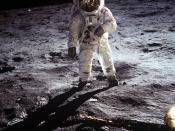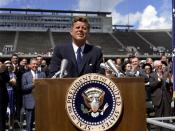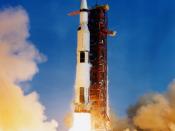The Apollo space missions date back to the "space race" which took place during the Cold War era. Sparked by the threat of Sputnik 1, a satellite sent into orbit in 1957 by the Soviet Union, the United States felt vulnerable, as they believed the Soviets were developing a method to launch ballistic missiles from space. While the United States felt obligated to catch up to the Soviets in the interest of national security, they also took on the challenge of staying one-step ahead of the Soviets for increased power and prestige in their ongoing political battle. The organization known today as NASA (National Aeronautics and Space Administration) was commissioned in 1958 with the sole purpose of developing America's technological ability to beat the Soviets in the space race. With the Soviet cosmonaut Yuri Gagarin becoming the first human in space just a few years later in 1961, President John F. Kennedy initiated the Apollo program on May 25 of that same year.
It was preceded by the Gemini program that American engineers would later find out to be useful in developing the techniques that would be needed for the ambitious trip to the moon. At the peak of Apollo preparations in 1965, NASA employed 36,000 civil servants, 376,700 contractor employees, and a yearly operating budget of $5.2 billion. Between 1961 and 1973, NASA spent approximately $25.4 billion on the Apollo missions. The United States eventually reached its goal of achieving lunar landing on July 20, 1969, when astronauts Neil Armstrong and Buzz Aldrin landed on the moon with Armstrong relaying his famous phrase to the millions around the world, "That's one small step for man ... one giant leap for mankind."
The Apollo program had a political, social, and economical impact on the United States because it animated the...


